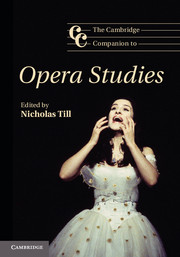Book contents
- Frontmatter
- Contents
- Contributors
- Acknowledgements
- Introduction: opera studies today
- Part One Institutions
- Part Two Constituents
- 4 ‘Too much music’: the media of opera
- 5 Voices and singers
- 6 Opera and modes of theatrical production
- 7 Opera and the technologies of theatrical production
- Part Three Forms
- Part Four Issues
- Further reading
- Index
- References
7 - Opera and the technologies of theatrical production
from Part Two - Constituents
Published online by Cambridge University Press: 05 December 2012
- Frontmatter
- Contents
- Contributors
- Acknowledgements
- Introduction: opera studies today
- Part One Institutions
- Part Two Constituents
- 4 ‘Too much music’: the media of opera
- 5 Voices and singers
- 6 Opera and modes of theatrical production
- 7 Opera and the technologies of theatrical production
- Part Three Forms
- Part Four Issues
- Further reading
- Index
- References
Summary
Flying machines
In the opening scene of Peter Sellars’s production of John Adams’s Nixon in China the audience derives special delight from a simply achieved scenic effect. After an opening chorus celebrating the successes of the Chinese Revolution – ‘the people are the heroes now’ – a two-dimensional painted replica of the front half of an aeroplane (The Spirit of ’76) is ‘flown’ into the stage. A three-dimensional and thus functional stepladder is wheeled into place so that when the figures of Richard and Patricia Nixon open the ‘door’ in the ‘plane’, they can step out of the simulated flying machine and into the solid real world of the playing space, pausing, of course, on the steps, to allow photographs to be taken and applause to be offered. This was a moment that gave this spectator particular pleasure at a performance of a revival of the production at English National Opera in 2006, nearly twenty years after its premiere at the opening of a new opera house in Houston, in October 1987. It would appear that this pleasure was also felt at the premiere, however, as the Los Angeles Times notes in its review of the opening night:
He [Peter Sellars] gives us a marvelous coup de theatre with the onstage arrival of the presidential jet (when Nixon steps down the gangway, he elicits applause from the Houstonians as well as the mock-Chinese welcoming committee).
I want to start by trying to account for the particular, theatrical pleasure of this moment, as a way of opening out into a wider discussion of the technologies of opera production in the theatre. The theatrical technology at work in Sellars’s production is both an instance of and a comic reference to the stage technologies around which opera, as a public theatrical event, originally took shape. When opera emerged from the courts and into the public theatres of Venice in the 1630s it did so as a spectacular entertainment, in which the effects which could be achieved by means of stage technologies were as significant a part of the production as music or singing.
- Type
- Chapter
- Information
- The Cambridge Companion to Opera Studies , pp. 159 - 176Publisher: Cambridge University PressPrint publication year: 2012
References
- 1
- Cited by

